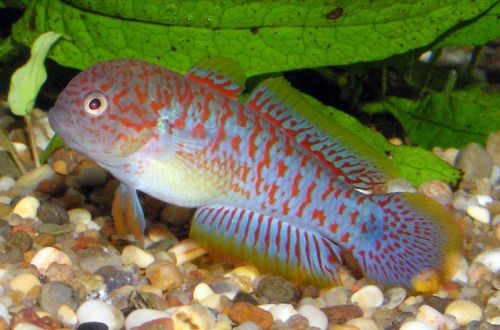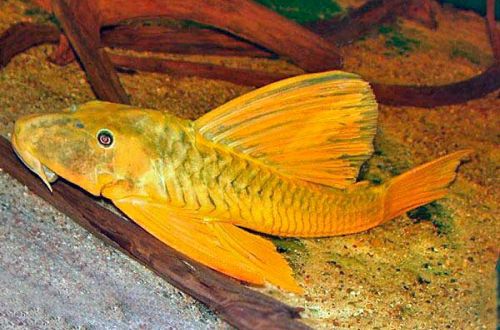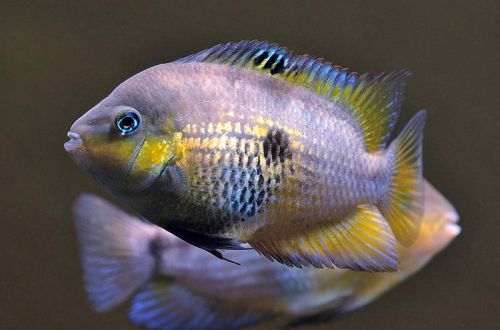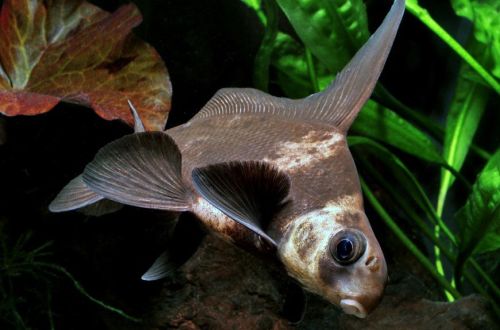
carpeted eliotris
Carpet eliotris, minnow “Peacock” or Peacock goby, scientific name Tateurndina ocellicauda, belongs to the Eleotridae family. Although the word “goby” is present in the name, it is not related to a similar group of fish that live on the Eurasian continent. Beautiful and easy to keep fish, compatible with many freshwater species. May be recommended for beginner aquarists.

Contents
Habitat
It comes from the island of Papua New Guinea, near Australia. It occurs at the eastern end of the lake in lowland rivers and lakes located among the tropical forest. Prefers shallow regions with loose substrate.
Brief information:
- The volume of the aquarium – from 40 liters.
- Temperature – 22-26°C
- Value pH — 6.5–7.5
- Water hardness – soft (5-10 dGH)
- Substrate type – dark soft
- Lighting – subdued
- Brackish water – no
- Water Movement – Low/Moderate
- The size of the fish is up to 7 cm.
- Food – any food
- Temperament – peaceful
- Content alone or in a group
Description
Adult individuals reach a length of about 7 cm. Sexual dimorphism is weakly expressed. Differences between male and female are negligible, except during spawning periods. In the mating season, males form a kind of occipital hump. It gives the fish an original appearance, which is reflected in the name – “Goby”.
Another feature is the structure of the dorsal fin, divided in two. This feature makes him related to other representatives of the Australian region – Rainbows. The coloration is blue with yellow tints and a pattern of red stripes and irregular strokes.
Food
It can be content with dry food, but prefers live and frozen food, such as bloodworms, daphnia, brine shrimp. This protein-rich diet promotes brighter coloration.
Maintenance and care, arrangement of the aquarium
The optimal size of the aquarium for one or two fish starts from 40 liters. The peacock goby should be kept in soft and slightly acidic water with plenty of aquatic plants. The use of dark soil and plants floating on the surface create, along with a subdued level of lighting, a favorable habitat. Be sure to have shelters, for example, in the form of snags or thickets of plants. In the absence of suitable secluded places, the fish will huddle near the equipment or in the corners of the aquarium. Since goby fish are famous for their jumping, the aquarium should be equipped with a lid to avoid accidental jumping.
Maintenance procedures are standard – this is a weekly replacement of part of the water with fresh water and regular cleaning of the soil and design elements from organic waste.
Behavior and Compatibility
It belongs to territorial species, nevertheless it is compatible with various peaceful fish of comparable size. Excellent neighbors in the aquarium will be Rainbows, Tetras, Rasboras, Corydoras catfish and the like. Carpet eliotris can be kept both singly and in a group. In the latter case, shelters should be provided for each fish.
Breeding / breeding
Breeding Gobies-peacocks is quite simple. The only difficulty is finding the right pair. Fish are picky about the choice of a partner, so the solution to the problem can be the purchase of an already formed pair, or the acquisition of a group of young fish, which, as they grow older, will find a suitable partner for themselves.
The onset of the mating season becomes noticeable in males, which develop a characteristic occipital hump. He occupies one of the shelters and proceeds to courtship. As soon as a pregnant female swims nearby, the male tries to lure her to him, sometimes by force. When the female is ready, she accepts courtship and lays dozens of eggs in the shelter. Then she swims away, and the male takes care and protection for future offspring, though only for a short incubation period, which lasts up to 2 days. After a couple of days, the fry will begin to swim freely. From now on, they should be transplanted into a separate tank, otherwise they will be eaten.
Fish diseases
Health problems arise only in case of injuries or when kept in unsuitable conditions, which depresses the immune system and, as a result, provokes the occurrence of any disease. In the event of the appearance of the first symptoms, first of all, it is necessary to check the water for the excess of certain indicators or the presence of dangerous concentrations of toxic substances (nitrites, nitrates, ammonium, etc.). If deviations are found, bring all values back to normal and only then proceed with treatment. Read more about symptoms and treatments in the Aquarium Fish Diseases section.





